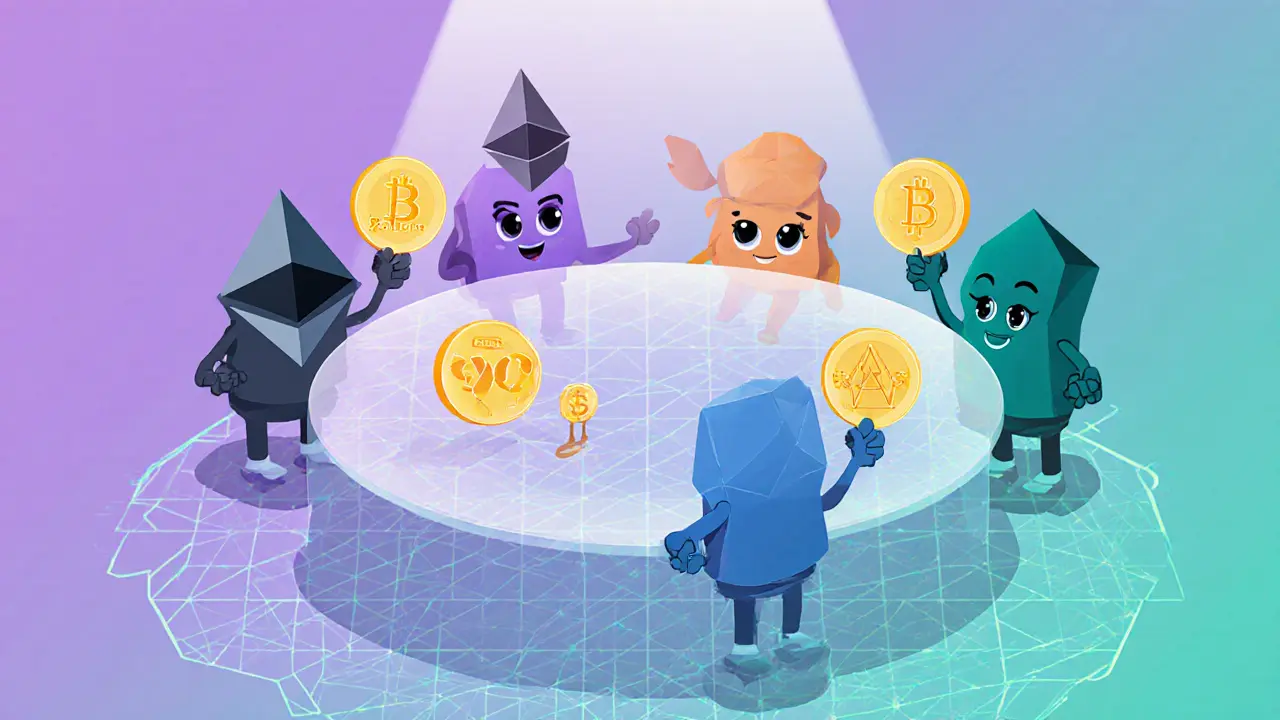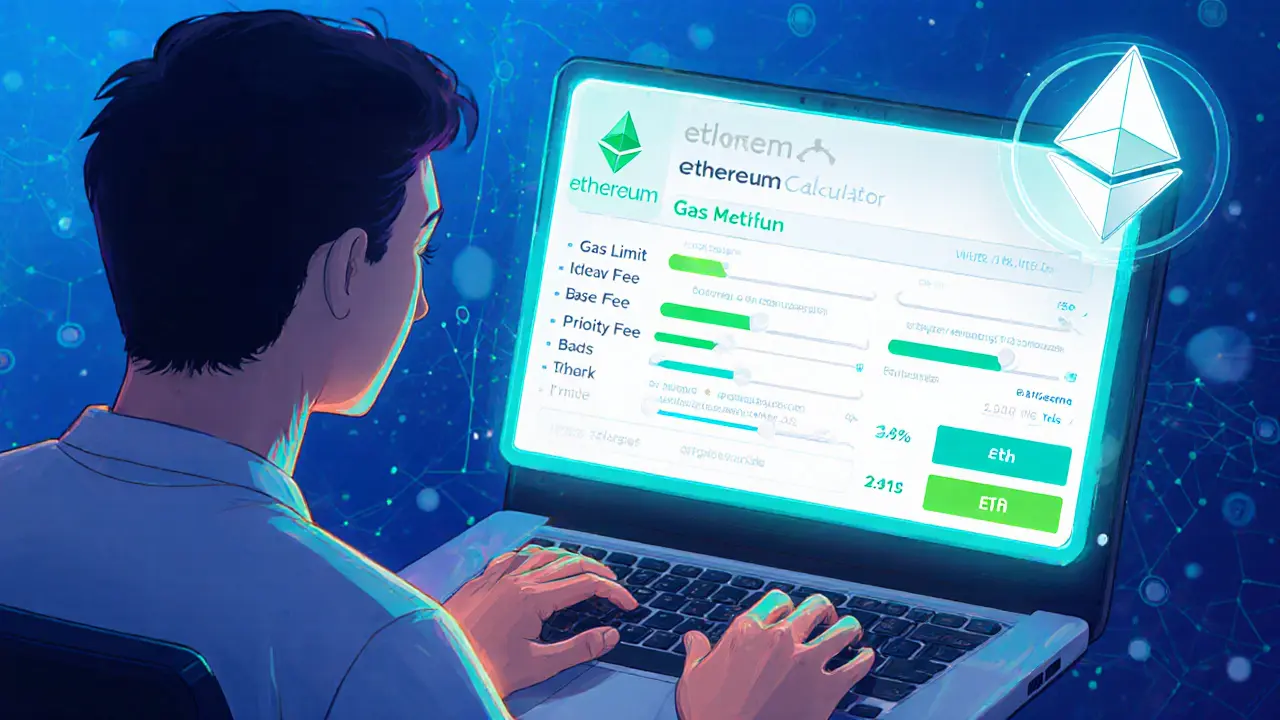Ethereum Gas Fee Calculator
Calculate Your Transaction Fee
Enter your transaction details to estimate the total cost in USD.
Estimated Transaction Cost
Fee Comparison Table (2025)
| Platform | Avg. Fee (USD) | Avg. Gas Price | Common Tx Type |
|---|---|---|---|
| Ethereum | $0.41 | 2.7 gwei | ERC-20 swap |
| Solana | $0.001 | ~0.0005 SOL (~$0.001) | Token transfer |
| Polygon (L2) | $0.02 | 0.35 gwei (equiv.) | NFT mint |
| Arbitrum | $0.03 | ~0.4 gwei (equiv.) | DeFi trade |
| Optimism | $0.03 | ~0.45 gwei (equiv.) | Smart-contract call |
Key Takeaways
- Ethereum’s average fee fell to $0.41 in February2025, a 94% drop from the 2024 peak.
- Layer‑2 networks (Arbitrum, Optimism, Polygon) now charge 90‑99% less than main‑net Ethereum.
- Solana still offers the lowest base fee, but its advantage narrows when Ethereum runs at sub‑0.5USD levels.
- Timing transactions for off‑peak windows can shave another 25‑40% off the cost.
- Future upgrades promise sub‑cent fees across all major use‑cases.
When you hear Ethereum gas fees are the tiny amounts of Ether paid to validators for running code on the network, the picture that comes to mind is often one of volatility and high prices. That perception changed dramatically after the 2025 Dencun upgrade added new data‑compression techniques and further optimized the fee market. The average price per transaction now hovers around $0.41, making everyday swaps and NFT mints affordable for the average user.
How Ethereum Gas Fees Are Calculated
Ethereum’s fee model has been governed by EIP‑1559 since August2021, introducing a base‑fee that auto‑adjusts to congestion and a tip (priority fee) for faster processing. The total cost follows a simple formula:
(Base fee + Priority fee) × Gas limit = Total fee
A standard ETH transfer consumes 21,000 gas units. With a gas price of 20gwei, the math looks like this:
21,000 × 20gwei = 420,000gwei = 0.00042ETH
One gwei equals 0.000000001ETH, so users can convert the raw number into a dollar value instantly using the current ETH/USD rate.
2025 Gas Fee Landscape
Data from February262025 shows an average gas price of 3.146gwei, down from 72gwei a year earlier-a 95% reduction. Daily network‑wide fee burn fell from $23million at the 2023 peak to $7.5million, indicating a healthier, less congested ecosystem.
Even during short spikes-like the $50‑per‑swap surge on February192025-fees quickly settled back below $1 as demand eased. The key drivers behind this stability are:
- Broad adoption of Layer2 solutions that process transactions off‑chain before anchoring them to Ethereum (Arbitrum, Optimism, Polygon).
- Improved wallet UI that surface real‑time gas estimates and let users set custom limits.
- Community‑driven timing strategies, with weekends and early mornings consistently offering the lowest fees.

Ethereum vs. Other Platforms
| Platform | Typical fee (USD) | Avg. gas price | Common transaction type | 2025 Highlight |
|---|---|---|---|---|
| Ethereum | $0.41 | 2.7gwei | ERC‑20 swap | 95% fee drop after Dencun |
| Solana | $0.001 | ~0.0005SOL (≈0.001USD) | Token transfer | Consistently low base fees |
| Polygon (L2) | $0.02 | 0.35gwei (equiv.) | NFT mint | 99% cheaper than Ethereum mainnet |
| Arbitrum | $0.03 | ~0.4gwei (equiv.) | DeFi trade | 90‑95% cost reduction |
| Optimism | $0.03 | ~0.45gwei (equiv.) | Smart‑contract call | Sub‑cent fees for most ops |
While Solana still leads on raw cost, Ethereum’s new baseline narrows the gap for everyday users. Moreover, the security model of Ethereum-still the industry‑standard for DeFi-means many are willing to pay a few cents extra for the added safety.
Layer2 Solutions: The Real Cost Cutters
Arbitrum and Optimism inherit Ethereum’s security through roll‑up proofs, yet they settle batches of transactions off‑chain. This reduces congestion on the main chain and brings fees down to a few cents. Polygon, originally a sidechain, now runs as an optimistic roll‑up, delivering sub‑cent fees while keeping compatibility with existing Ethereum tools.
Typical fee breakdown on a Layer2 transaction looks like:
- Pay a small L2 fee (≈0.03USD) to the roll‑up’s sequencer.
- Periodically, the roll‑up posts a batch proof to Ethereum, incurring a one‑time main‑net fee (often < $0.10).
- Withdrawals back to Ethereum trigger a final on‑chain transaction, so users plan withdrawals when fees are low.
For DeFi traders, the net effect is a 90‑99% reduction compared to a direct Ethereum swap.
Practical Tips to Keep Fees Low
- Check gas trackers. Websites like etherscan.io/gastracker display real‑time base‑fee trends.
- Schedule non‑urgent swaps for weekends or early mornings (UTC0‑6).
- Use wallet “max‑priority‑fee” sliders to set the lowest tip that still guarantees inclusion.
- Prefer Layer2 bridges for frequent trades; only move funds to main‑net when you need ETH for staking or large contracts.
- Set a realistic gas limit. Over‑estimating wastes ETH; under‑estimating leads to failed transactions and extra cost.
Most wallets now alert you if your gas limit is too high for the chosen operation, so it’s safe to rely on those warnings.
Future Outlook: Where Are Fees Headed?
The Ethereum roadmap includes two promising avenues:
- Further roll‑up integration. More specialized roll‑ups (e.g., zk‑Rollups) could push fees below $0.01 for bulk payments.
- Base‑layer fee optimizations. After Dencun, the Foundation is experimenting with adaptive block sizes that could smooth out spikes without compromising security.
Analysts predict that by the end of 2025, average transaction costs across the ecosystem will cluster around the $0.02‑$0.05 range, making crypto truly viable for micro‑payments and everyday commerce.

Frequently Asked Questions
Why are Ethereum fees still higher than Solana’s?
Ethereum prioritises decentralisation and security, which requires more computational work per transaction. Solana’s design sacrifices some decentralisation for speed, resulting in lower base fees.
Can I avoid all fees by using only Layer2?
Not entirely. While most everyday actions stay on L2, moving funds back to Ethereum’s main net incurs a small on‑chain fee. Planning withdrawals during low‑fee periods minimizes the impact.
How do I calculate the exact fee before sending?
Multiply the gas limit of your transaction by the sum of the current base fee and your chosen priority fee (both in gwei). Convert the resulting gwei to ETH, then multiply by the current ETH/USD price.
Do fee spikes still happen in 2025?
Yes, especially during major NFT drops, popular DeFi launches, or sudden market rallies. Monitoring gas trackers and postponing non‑critical actions can avoid the worst spikes.
Is the Dencun upgrade a one‑time fix?
It’s a major milestone, but Ethereum continues to evolve. Future upgrades (e.g., more roll‑up‑friendly changes) will further compress data and keep fees trending down.


LeAnn Dolly-Powell
OMG I can finally mint my NFTs without crying 😭💖 This is the best news since pizza delivery got cheaper!